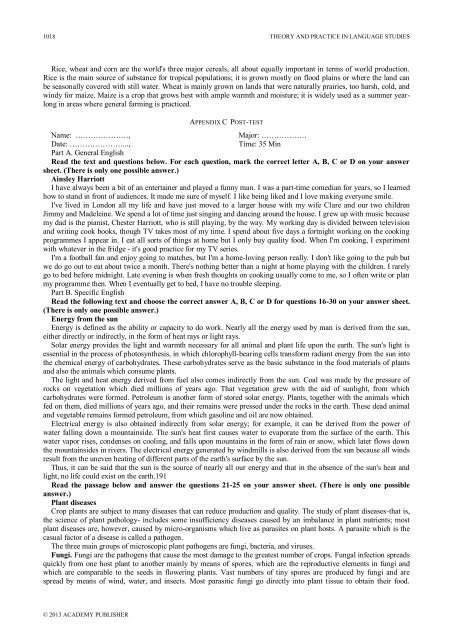Theory and Practice in Language Studies Contents - Academy ...
Theory and Practice in Language Studies Contents - Academy ...
Theory and Practice in Language Studies Contents - Academy ...
You also want an ePaper? Increase the reach of your titles
YUMPU automatically turns print PDFs into web optimized ePapers that Google loves.
1018 THEORY AND PRACTICE IN LANGUAGE STUDIESRice, wheat <strong>and</strong> corn are the world's three major cereals, all about equally important <strong>in</strong> terms of world production.Rice is the ma<strong>in</strong> source of substance for tropical populations; it is grown mostly on flood pla<strong>in</strong>s or where the l<strong>and</strong> canbe seasonally covered with still water. Wheat is ma<strong>in</strong>ly grown on l<strong>and</strong>s that were naturally prairies, too harsh, cold, <strong>and</strong>w<strong>in</strong>dy for maize. Maize is a crop that grows best with ample warmth <strong>and</strong> moisture; it is widely used as a summer yearlong<strong>in</strong> areas where general farm<strong>in</strong>g is practiced.APPENDIX C POST-TESTName: …………………,Major: ………………Date: …………………...,Time: 35 M<strong>in</strong>Part A. General EnglishRead the text <strong>and</strong> questions below. For each question, mark the correct letter A, B, C or D on your answersheet. (There is only one possible answer.)A<strong>in</strong>sley HarriottI have always been a bit of an enterta<strong>in</strong>er <strong>and</strong> played a funny man. I was a part-time comedian for years, so I learnedhow to st<strong>and</strong> <strong>in</strong> front of audiences. It made me sure of myself. I like be<strong>in</strong>g liked <strong>and</strong> I love mak<strong>in</strong>g everyone smile.I've lived <strong>in</strong> London all my life <strong>and</strong> have just moved to a larger house with my wife Clare <strong>and</strong> our two childrenJimmy <strong>and</strong> Madele<strong>in</strong>e. We spend a lot of time just s<strong>in</strong>g<strong>in</strong>g <strong>and</strong> danc<strong>in</strong>g around the house. I grew up with music becausemy dad is the pianist, Chester Harriott, who is still play<strong>in</strong>g, by the way. My work<strong>in</strong>g day is divided between television<strong>and</strong> writ<strong>in</strong>g cook books, though TV takes most of my time. I spend about five days a fortnight work<strong>in</strong>g on the cook<strong>in</strong>gprogrammes I appear <strong>in</strong>. I eat all sorts of th<strong>in</strong>gs at home but I only buy quality food. When I'm cook<strong>in</strong>g, I experimentwith whatever <strong>in</strong> the fridge - it's good practice for my TV series.I'm a football fan <strong>and</strong> enjoy go<strong>in</strong>g to matches, but I'm a home-lov<strong>in</strong>g person really. I don't like go<strong>in</strong>g to the pub butwe do go out to eat about twice a month. There's noth<strong>in</strong>g better than a night at home play<strong>in</strong>g with the children. I rarelygo to bed before midnight. Late even<strong>in</strong>g is when fresh thoughts on cook<strong>in</strong>g usually come to me, so I often write or planmy programme then. When I eventually get to bed, I have no trouble sleep<strong>in</strong>g.Part B. Specific EnglishRead the follow<strong>in</strong>g text <strong>and</strong> choose the correct answer A, B, C or D for questions 16-30 on your answer sheet.(There is only one possible answer.)Energy from the sunEnergy is def<strong>in</strong>ed as the ability or capacity to do work. Nearly all the energy used by man is derived from the sun,either directly or <strong>in</strong>directly, <strong>in</strong> the form of heat rays or light rays.Solar energy provides the light <strong>and</strong> warmth necessary for all animal <strong>and</strong> plant life upon the earth. The sun's light isessential <strong>in</strong> the process of photosynthesis, <strong>in</strong> which chlorophyll-bear<strong>in</strong>g cells transform radiant energy from the sun <strong>in</strong>tothe chemical energy of carbohydrates. These carbohydrates serve as the basic substance <strong>in</strong> the food materials of plants<strong>and</strong> also the animals which consume plants.The light <strong>and</strong> heat energy derived from fuel also comes <strong>in</strong>directly from the sun. Coal was made by the pressure ofrocks on vegetation which died millions of years ago. That vegetation grew with the aid of sunlight, from whichcarbohydrates were formed. Petroleum is another form of stored solar energy. Plants, together with the animals whichfed on them, died millions of years ago, <strong>and</strong> their rema<strong>in</strong>s were pressed under the rocks <strong>in</strong> the earth. These dead animal<strong>and</strong> vegetable rema<strong>in</strong>s formed petroleum, from which gasol<strong>in</strong>e <strong>and</strong> oil are now obta<strong>in</strong>ed.Electrical energy is also obta<strong>in</strong>ed <strong>in</strong>directly from solar energy; for example, it can be derived from the power ofwater fall<strong>in</strong>g down a mounta<strong>in</strong>side. The sun's heat first causes water to evaporate from the surface of the earth. Thiswater vapor rises, condenses on cool<strong>in</strong>g, <strong>and</strong> falls upon mounta<strong>in</strong>s <strong>in</strong> the form of ra<strong>in</strong> or snow, which later flows downthe mounta<strong>in</strong>sides <strong>in</strong> rivers. The electrical energy generated by w<strong>in</strong>dmills is also derived from the sun because all w<strong>in</strong>dsresult from the uneven heat<strong>in</strong>g of different parts of the earth's surface by the sun.Thus, it can be said that the sun is the source of nearly all our energy <strong>and</strong> that <strong>in</strong> the absence of the sun's heat <strong>and</strong>light, no life could exist on the earth.191Read the passage below <strong>and</strong> answer the questions 21-25 on your answer sheet. (There is only one possibleanswer.)Plant diseasesCrop plants are subject to many diseases that can reduce production <strong>and</strong> quality. The study of plant diseases-that is,the science of plant pathology- <strong>in</strong>cludes some <strong>in</strong>sufficiency diseases caused by an imbalance <strong>in</strong> plant nutrients; mostplant diseases are, however, caused by micro-organisms which live as parasites on plant hosts. A parasite which is thecasual factor of a disease is called a pathogen.The three ma<strong>in</strong> groups of microscopic plant pathogens are fungi, bacteria, <strong>and</strong> viruses.Fungi. Fungi are the pathogens that cause the most damage to the greatest number of crops. Fungal <strong>in</strong>fection spreadsquickly from one host plant to another ma<strong>in</strong>ly by means of spores, which are the reproductive elements <strong>in</strong> fungi <strong>and</strong>which are comparable to the seeds <strong>in</strong> flower<strong>in</strong>g plants. Vast numbers of t<strong>in</strong>y spores are produced by fungi <strong>and</strong> arespread by means of w<strong>in</strong>d, water, <strong>and</strong> <strong>in</strong>sects. Most parasitic fungi go directly <strong>in</strong>to plant tissue to obta<strong>in</strong> their food.© 2013 ACADEMY PUBLISHER
















